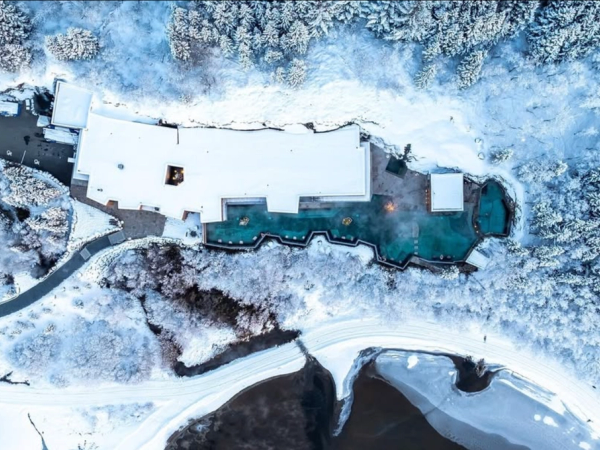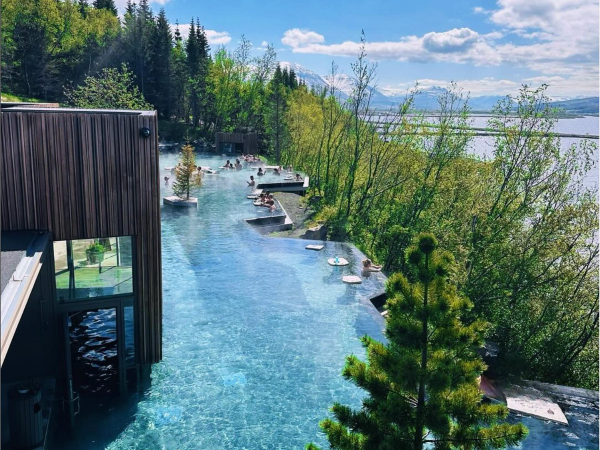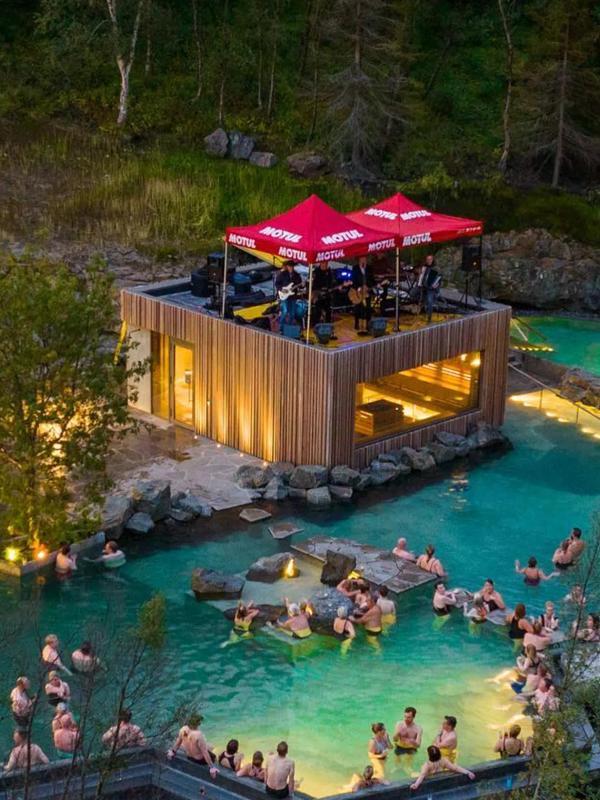
Relax in North Iceland: Everything About the Forest Lagoon
One of the best activities to enjoy when traveling to Iceland is taking a geothermal bath. Many travelers come to the country hoping to discover one of the many natural hot springs and spas all over the island.
One of the latest additions to the list is the spectacular Forest Lagoon, located outside Akureyri, the second largest city in Iceland, and a fantastic stop in your campervan itinerary through the country for a blend of relaxation and natural beauty.
In this guide, we’ll cover all there’s to know about the Forest Lagoon, as well as places where you can with your campervan to spend the night.
Key Takeaways
- The Forest Lagoon is a geothermal spa located outside Akureyri, in North Iceland.
- It was opened in 2022 using natural geothermal waters from the nearby mountains.
- The spa has fantastic facilities and great views of the Eyjafjörður fjord.
What is the Forest Lagoon?
Surrounded by birch and pine trees, in the middle of Vaðlaskógur forest, the Forest Lagoon, or Skógarböðin in Icelandic, is a geothermal spa that opened its doors in 2022. However, its story begins a few years earlier, unexpectedly.
In 2015, workers digging a tunnel near Akureyri struck a hot spring, revealing what later became a natural treasure hidden beneath Vaðlaheiði mountain. Today, this place is a modern spa designed to perfectly blend and harmonize with its surroundings. Here, visitors are offered the chance to soak in crystal-clear geothermal waters while enjoying views of an astonishing fjord with snow-covered mountains behind it.
The lagoon features two main pools, both fed by the mineral-rich waters of the hot spring. The larger pool is quite big, perfect for floating or standing, with a swim-up bar where you can enjoy a drink without leaving the water. This pool is kept at 37°C (98.6°F). A smaller, hotter pool, around 40°C (104°F), provides a cozier environment. Then we have the cold plunge, which is at 11°C (51.8°F). The contrast of temperatures between the two hot pools and this one is beneficial for the skin and blood circulation.
There’s also a Finnish-style dry sauna, with large windows so you can still enjoy the views inside it. The temperature inside the sauna is 80°C (176°F) and the humidity is low, around 20%. The changing facilities are modern, with lockers, private and open showers equipped with shampoo, conditioner, and shower gel, ensuring a comfortable experience, but you are welcome to bring your own if you prefer.
For a complete experience, you can have dinner in the Forest Bistro, a restaurant that is part of the facilities. They serve delicious, traditional Icelandic food made with local ingredients in a cozy setting with an open fire. The restaurant is not included in the spa admission.
Bathing culture runs deep in Iceland. The natives have used and known the benefits of geothermal waters for centuries, and they continue to do so today. Icelanders tend to go to natural hot springs or artificial spas to relax, socialize, and even conduct business. It’s a tradition that continues at places like the Forest Lagoon. T
he waters here are clear, naturally hot as a result of geothermal activity, filtered through basalt rocks. The architects of this place created a design that emphasizes its connection with nature, blending it with the forest around.
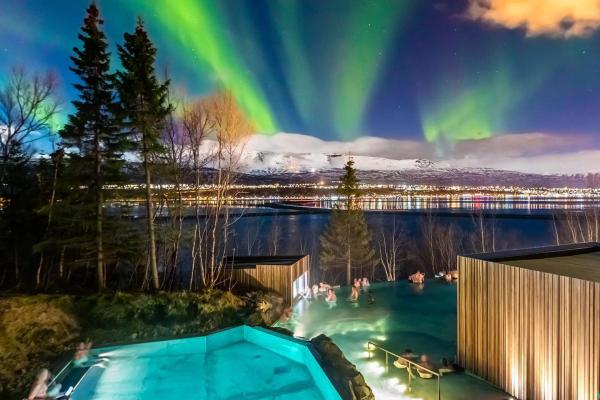
General Information About the Forest Lagoon
The Forest Lagoon operates daily from 9:00 AM to midnight, giving plenty of options for travelers to choose the best time and relax before or after a day of exploration. It’s pretty big and can fit up to 200 people at once, but it’s always better to reserve in advance through their website.
Entrance Fees
- Adults: 6,900 ISK (45€ or 50$).
- Children (ages 6–15): 3,450 ISK (22.75€ or 25$).
- Seniors (67+) and disabled visitors: 5,250 ISK (34.50€ or 38$).
- Children under 5: Free.
The entry fee includes access to all pools, the sauna, and changing facilities. Towels, swimsuits, and robes can be rented for a small fee, but you are more than welcome to bring your own. The Forest Lagoon provides hand soap, shower gel, shampoo, conditioner, and body lotion for guests, but again, you can bring them if you prefer.
At the entrance, you’ll receive a wristband for cashless purchases at the bar or bistro, settled upon exit. As we were saying, pre-booking is recommended, especially during peak summer months or when cruise ships dock in Akureyri, to secure your spot.
The spa is designed for relaxation, with a capacity big enough to not feel packed, but that keeps crowds manageable compared to larger geothermal sites.
There’s a free parking area for customers near the entrance. If you’re staying in Akureyri and don’t want to drive, there’s a free shuttle bus that departs from the Hof Cultural Center in downtown Akureyri and back. The facility is accessible, with ramps and spacious changing areas, but the forest setting may present minor challenges for people with mobility issues.
Don’t forget that there’s bathing etiquette in Iceland that everyone must follow. It’s mandatory to shower thoroughly naked before entering the pools to maintain hygiene.
All the prices are as of summer 2025.
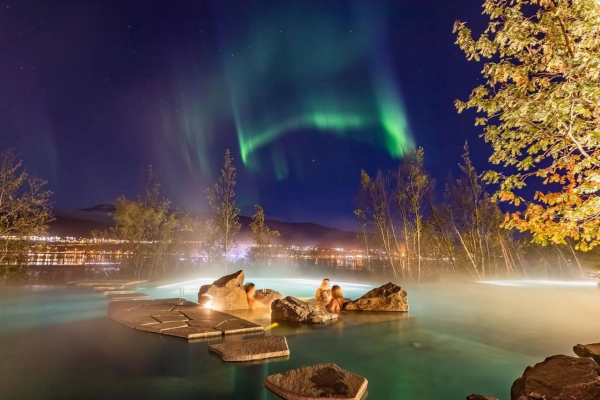
Where’s the Forest Lagoon and How to Get There
This fantastic spa is located just 3.6 kilometers (2.2 miles) from Akureyri, the biggest city in North Iceland and the second largest in the country. If you’re going to start your trip to the Forest Lagoon from Reykjavík, the drive is quite long, but very easy to follow.
The total itinerary is 391 kilometers (243 miles) along the Ring Road (Route 1), a scenic drive that takes about five hours. Start by heading north from the capital, passing through the Hvalfjörður tunnel and along the western coast before cutting inland toward Akureyri. Along the way, you’ll enjoy breathtaking views of mountains, fjords, and meadows. If you have time, consider planning your route north over two or three days, making stops along the way to explore different attractions.
Once you’ve reached Akureyri, you have to drive through the city and cross the bridge over the Eyjafjörður fjord. Just after it, you’ll see a road to the right with a big sign that reads Skógarböðin, the Icelandic name for the Forest Lagoon. The parking area is just off the road.
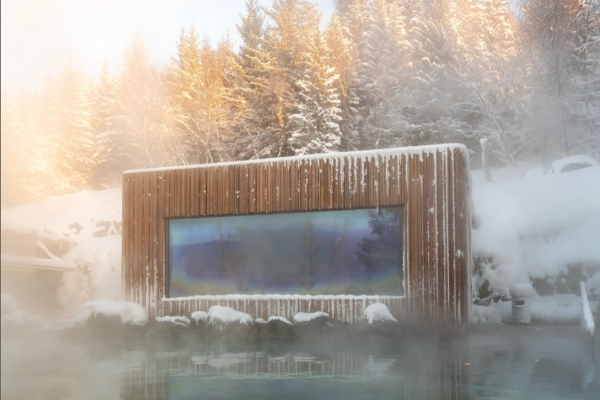
What to See and Do Near the Forest Lagoon
North Iceland is a region that is not as well-known or visited as other parts of the country. Its location, far from Keflavik, the main international airport in Iceland, makes it less accessible for short trips. However, it’s one of the most astonishing and diverse parts you can visit, full of amazing natural monuments.
The Forest Lagoon is quite close to the Diamond Circle, one of the best scenic routes in Iceland, which makes it a great stop in an itinerary through this region.
Akureyri
As we have already mentioned, the “capital of North Iceland” is just a stone’s throw from the Forest Lagoon, just 3.6 kilometers (2.2 miles) away. Stroll through the botanical gardens to see Iceland’s native flora, visit the Akureyri Museum for a dive into local history, or explore the Motorcycle Museum for a look at vintage bikes. The town’s colorful streets, full of cafes and shops, are perfect for connecting with the cultural side of Iceland. The most iconic building in town is the Akureyri Church, with its distinctive architectural style. The city is a great place to try some real Icelandic food.
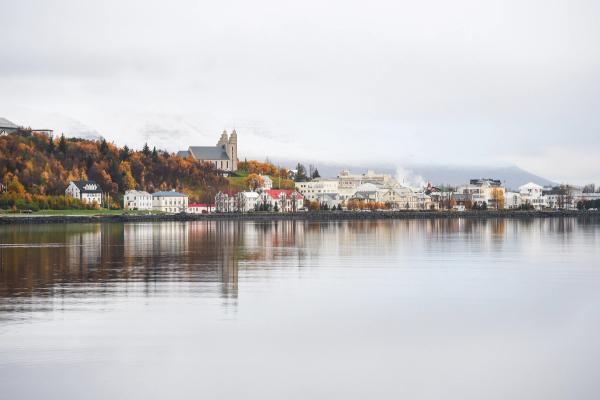
Goðafoss
This waterfall is one of the five main stops of the Diamond Circle, and it’s just 25 kilometers (15.5 miles) east of the Forest Lagoon. Although it’s not as impressive in size as many other tall waterfalls in Iceland, it’s just 12 meters high (39 feet) and 30 meters (98 feet) wide, it is one of the prettiest in the country. It is crescent-shaped, with turquoise waters that fall over basalt rocks into the river below.
In Icelandic, Goðafoss means “Waterfall of the Gods.” You'd think it's due its heavenly looks, but it’s more historical than that. In the year 1000 AD, local chieftain and lawspeaker Þorgeir Ljósvetningagoði threw his pagan idols into the waterfall to symbolize the nation’s conversion to Christianity.
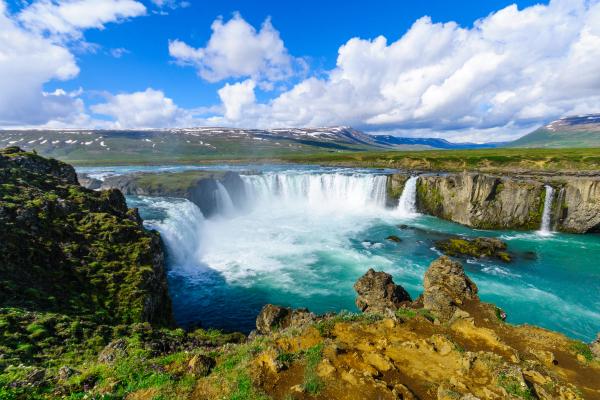
Lake Mývatn
Formed by an eruption over 2,000 years ago, Lake Mývatn is a volcanic wonderland. This lake, with its water of an intense blue hue, is surrounded by lava fields and bubbling mud pots, as it is an active geothermal area. You’ll also find pseudo craters, formed when lava met water and cooled down rapidly.
The lake is surrounded by wetlands that are full of different bird species, such as the harlequin duck, the tufted duck, and the common snipe, among others. Summer is the best time to see them.
Close to the lake’s shore, there’s another fantastic geothermal spa, the Mývatn Nature Baths. If you go to Lake Mývatn, don’t miss Dimmuborgir, a labyrinth of unique lava formations.
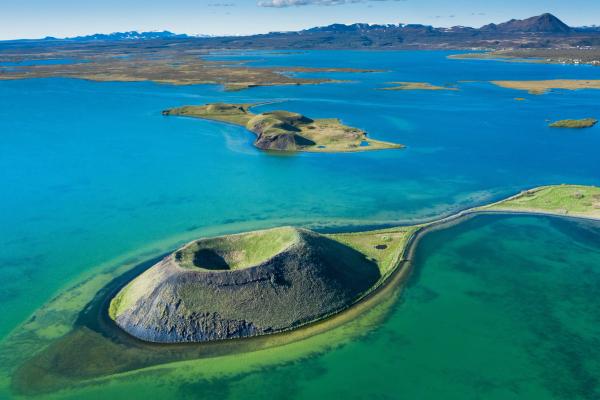
Ásbyrgi Canyon
A bit further north, we can find one of the most geologically astonishing places in all of Iceland. Ásbyrgi is a horseshoe-shaped canyon with tall cliffs -up to 100 meters (328 feet)- and a birch forest with a pond at the bottom.
There are several trails to explore the area entirely, with different lengths and levels of difficulty.
It’s a place with a strong connection with Norse mythology, as the legend says it was formed when Sleipnir, Odin’s eight-legged horse, struck the land with its hoof.
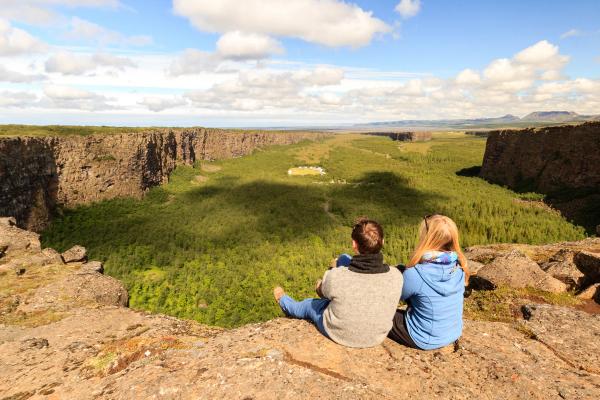
Dettifoss
There’s another waterfall that is part of the Diamond Circle, but a very different sight compared to Goðafoss. Measuring 44 meters (144 feet) high and 100 meters (328 feet) wide, Dettifoss is Europe’s second most powerful waterfall. Its raw power makes one feel really small, and its roar can be heard from quite some distance.
A short hike from the parking lot leads to different viewpoints, one on each side of the river.
There are two smaller waterfalls nearby, Selfoss and Hafragilsfoss, both within walking distance, making the experience even better.
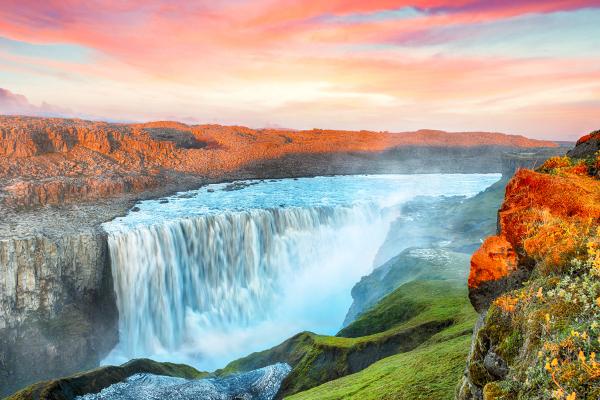
Húsavík
If watching whales is on your Iceland bucket list, then this is the best place for it. Known as the “Capital of whale watching”, Húsavík is a charming town.
Several companies operate boat tours from the town’s harbor. The vessels go deep into Skjálfandi Bay, where there are high chances to spot orcas, humpback whales, and Minke whales, especially in the summer months. The town’s Whale Museum and charming harbor add to its appeal.
For a unique geothermal experience, visit the nearby GeoSea baths, a unique spa that uses geothermal seawater.
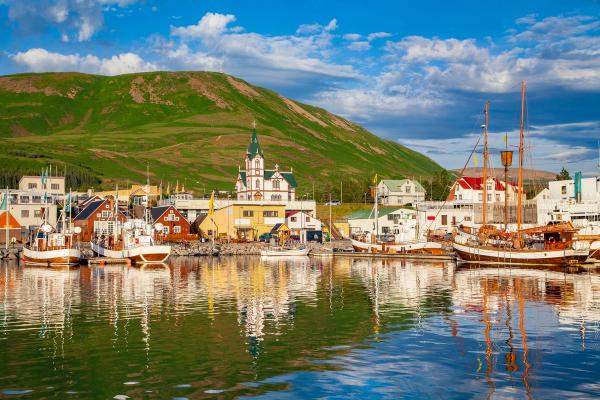
Where to Stay Near the Forest Lagoon
Camping culture is strong in Iceland, with campsites scattered throughout the country where you can spend the night with your campervan. It’s important to know that wild camping is illegal in Iceland. Here you have some options close to the Forest Lagoon.
Lónsá Campsite
Distance to the Forest Lagoon: 7.4 km (4.6 miles). Opening Period: May to September.
Just outside Akureyri, Lónsá is a quiet and basic camping ground with views of the mountains and the fjord. It has toilets, showers, electricity hookups, and an area to do the dishes. Its proximity to Akureyri and the lagoon makes it ideal for day trips.
Vaglaskógur Camping Site
Distance to the Forest Lagoon: 15 km (9.3 miles). Opening Period: May to September.
Set in the heart of Vaglaskógur forest, this campsite is one of the most complete camping grounds in North Iceland, surrounded by birch and pine trees. The facilities include toilets, showers, electricity, a washing machine and dryer, a children's playground, and sheltered pitches for windy days. It’s accessible for people with reduced mobility.
Systragil Camping Ground
Distance to Forest Lagoon: 13 km (8.1 miles) Opening Period: June to August
Located very close to Vaglaskógur, it has spacious pitches for tents and campervans sheltered by trees, toilets, showers, electricity, a washing machine and dryer, and cooking facilities. Its location near Goðafoss and Lake Mývatn makes it a strategic base for exploring the Diamond Circle.
Eyjafjarðarsveit Campsite
Distance to Forest Lagoon: 13 km (8 miles). Opening Period: June to August.
Situated near Hrafnagil school, this family-friendly campsite offers a grassy area for campervans with toilets, showers, washing machine, and electricity. It’s a fantastic option if you’re traveling with children, as it has several activities kids can enjoy and is in a beautiful valley with a small creek nearby. Its proximity to Akureyri ensures easy access to shops and restaurants.
Ártún
Distance to Forest Lagoon: 27 km (17 miles). Opening Period: May to September.
One of the best camping grounds in the region, Ártún is also a guesthouse and bed and breakfast. It has pitches for tents and campervans of all sizes, with toilets, showers, indoor dining areas, electricity, waste disposal, and Wi-Fi. They also have five rooms in the guesthouse and a bungalow for 4 people.
The Weather at the Forest Lagoon
The climate in North Iceland is a bit colder than the south and west of the country. On the other hand, it’s fairly dry, but the weather, as it happens in the whole country, changes a lot and is unpredictable. Here’s what you can expect in each season:
Spring (April and May)
After the long winter, the fields and forests start to wake up, revealing their true colors. Temperatures are still a bit cold, with an average between 0°C and 7°C (32°F to 45°F). Expect a mix of rain, snow, and occasional sunny days. The lagoon’s warm waters are a perfect contrast to chilly air, and fewer tourists mean a quieter experience. However, there still can be closed roads due to snow and muddy trails, so check the conditions before traveling.
Summer (June to August)
Summer is the peak season, with mild temperatures of 10°C to 15°C (50°F to 59°F) and long daylight hours. By the end of June, the sun barely sets, so you’ll have the chance to enjoy the Forest Lagoon with natural light at all times. It’s the season with more tourists, so it’s especially important to book in the spa with time in advance. Light rain is common, so pack waterproof clothes.
Autumn (September and October)
Autumn comes with lower temperatures, from 3°C to 10°C (37°F to 50°F) and more chances of rain. There could be the first days of snow by October, so prepare accordingly. On the other hand, the forest that surrounds the lagoon has beautiful colors. The days shorten by the week, but the Northern Lights start to be visible in this season. So, if you’re lucky enough, you can enjoy an evening bath under the aurora.
Winter (November to March)
Winter transforms the area into a snowy wonderland, but the temperatures are quite low, from -5°C to 3°C (23°F to 37°F). But there’s no better feeling than being inside the hot water, feeling relaxed, while outside the temperature is around freezing point. There are not many visitors, so you can have the lagoon almost for yourself, but the conditions for traveling can be a bit complicated.
Travel Tips
- Book Ahead: Reserve your tickets to the Forest Lagoon and campsites early, especially in summer. Use parka.is for campsite bookings.
- Pack Smart: Bring a swimsuit, flip-flops, and a towel. They can be rented there, but this way you’ll save money.
- Campervan Prep: If you’re traveling in winter, early spring or late autumn, make sure your vehicle is equipped with the appropriate tires. Gas stations can be scarce outside towns, so fill up your tank whenever possible.
- Bathing Etiquette: Shower thoroughly before entering the pools, and mind your voice volume, as people come to the lagoon to relax.
- Combine Attractions: Make the most of your day and plan visits to some amazing natural monuments in the Diamond Circle. End your day with a relaxing stop at the Forest Lagoon.
- Check the Weather Forecast: Iceland’s weather changes fast. Use the Icelandic Met Office for forecasts to plan your driving and outdoor activities.
- Try the Food: The Forest Bistro serves great Icelandic food, and it could be a good option to try it.
Conclusion
The Forest Lagoon is one of the best activities one can enjoy in North Iceland. It’s a great spa, perfect for relaxation in the middle of a beautiful setting. It combines modern facilities with the traditional Icelandic bathing experience. You can connect with this part of the country’s culture in a place of easy access that is also close to some of the best natural monuments in the country.




